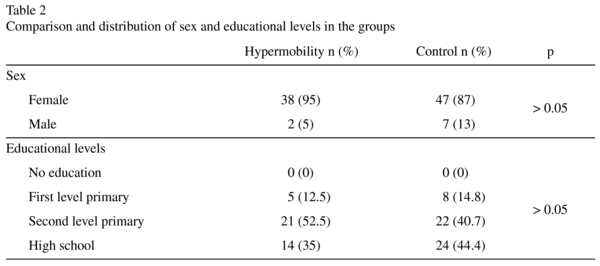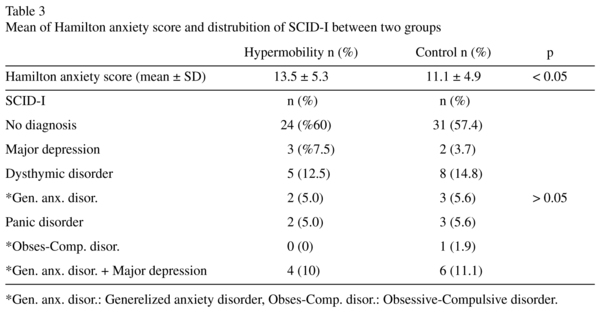My SciELO
Services on Demand
Journal
Article
Indicators
-
 Cited by SciELO
Cited by SciELO -
 Access statistics
Access statistics
Related links
-
 Cited by Google
Cited by Google -
 Similars in
SciELO
Similars in
SciELO -
 Similars in Google
Similars in Google
Share
The European Journal of Psychiatry
Print version ISSN 0213-6163
Eur. J. Psychiat. vol.24 n.4 Zaragoza Oct./Dec. 2010
The anxiety between individuals with and without joint hypermobility
Gulcan Gurer*; Faruk Sendur**; Bulent Kadri Gultekin***; Mehmet Erkan Ozcan****
* Department of Rheumatology, Van Research and Training Hospital, Van
** Department of Physical Medicine and Rehabilitation, Adnan Menderes University Medical School Hospital
*** Department of Psychiatry, Adnan Menderes University Medical School Hospital
**** Department of Psychiatry, Fatih University Medical School Hospital. Turkey
ABSTRACT
Background and Objectives: This study was performed to compare the anxiety disorders between individuals with and without joint hypermobility.
Methods: A total of 94 Turkish volunteers, 40 subjects (38 females, 2 males) with joint hypermobility and 54 controls (47 females, 7 males) without joint hypermobility, were included in this study. We evaluated the joint hypermobility by using the Beighton scoring system in the participants and a Beighton score of at least 4 was considered as joint hypermobility. In addition, all cases were evaluated with Structured Clinical Interview for DSM-IV Axis I Disorders (SCID-I) and Hamilton Anxiety Rating Scale by a psychiatrist in order to define their psychyatric disorders and anxiety levels, respectively.
Results: Age, gender and educational levels of the participants were similar between these two groups. Mean of anxiety score was higher statistically in the study group (13.5 ± 5.3) than that of the control group (11.1 ± 4.9) (p < 0.05). No statistically a significant difference in the ratio of psychyatric disorders according to SCID-I were observed between cases with and without hypermobility.
Conclusions: Anxiety scores have been found significantly higher in the group with hypermobility than that of the group without hypermobility. We strongly recommend the assessment of medical conditions, including joint hypermobility syndrome, in anxiety patients.
Key words: Hypermobility; Anxiety; Depression; Panic disorder; Obsessive-compulsive disorder.
Introduction
Joint hypermobility is a highly heritable clinical condition characterized by an increased distensibility of joints in passive movements and hypermobility in active movements1. Its prevalence in the general population appears to range between 10% and 15%, and it is more common in women than in men. A strong association between joint hypermobility and anxiety disorders, which has been found both in clinical2 and also in nonclinical populations3, must be considered. Interestingly, joint hypermobility and anxiety disorders have similar prevalence in the general population, between 10% and 15%, and have similar female predominance (3:1). Although joint hypermobility syndrome often goes unnoticed, affected individuals may suffer from repeated injuries of the musculoskeletal system3.
Aim of this study was to compare the anxiety and other psychyatric disorders (major depression, panic, dysthymic, generalized anxiety, and obsessive-compulsive disorders) between individuals with and without hypermobility.
Participants and Methods
A total of 94 Turkish volunteers who we-re admitted to the Rheumatology Outpatient Clinic of Adnan Menderes University, 40 subjects (38 females, 2 males) with joint hypermobility and 54 controls (47 females, 7 males) without hypermobility, were enrolled in this study. Participants had no psychiatric disease that was diagnosed in their medical story.
A physical examination, including the measurement of height and body weight was performed. The educational levels were interrogated and recorded.
In this study, joint hypermobility was evaluated in the participants by using the Beighton scoring system4, and a Beighton score of at least 4 was considered as joint hypermobility. Generally, a Beighton score of at least 4 is defined as hypermobility5-9.
Forty hypermobil subjects were defined as a study group and 54 age and sex-matched participants that had Beighton score 0 were constituted as a control group.
The psychiatrist who performed the psychiatric evaluation did not know to which group each individual belonged. All cases were subjected to Structured Clinical Interview for DSM-IV Axis I Disorders (SCID-I)10 and Hamilton Anxiety Rating Scale by a psychiatrist in order to determine their psychyatric disorders and anxiety levels, respectively. Because of all participants were Turkish, the Turkish version of the SCID-I11 and Hamilton Anxiety Rating Scale were used12.
Mean difference of age and BMI values among two groups were assessed by using independent-samples t test. The Mann-Whitney U test was used to compare the sex, educational levels and anxiety disorders of subjects with and without hypermobility.
Results
There was no significant difference between these two groups by means of age and BMI (p > 0.05). Mean of beighton score was determined to be statistically higher in study group than that of the control group (p < 0.001) (Table 1).
No statistically a significant difference was found by educational levels and sex between these groups (p > 0.05) (Table 2).
The mean of anxiety score in the hypermobility group were found to be significantly higher than that of the control group (p < 0.05). No statistically a significant difference in the ratio and frequency of psychyatric disorders according to SCID-I were observed between cases with and without hypermobility (p > 0.05) (Table 3).
Discussion
In this study, we aimed to investigate the anxiety levels and frequency of other psychological disorders (major depression, panic, dysthymic, generalized anxiety, and obsessive-compulsive disorders) between individuals with and without joint hypermobility. Consequently, mean anxiety score was found significantly higher in the study group than that in the control group.
Bulbena et al.3 reported that the correlations of joint laxity with trait anxiety were significant. Subjects (N = 526) were assessed with the Hospital del Mar hypermobility criteria and the State-Trait Anxiety Inventory. Scores for trait anxiety, and to a lesser extent state anxiety, were significantly higher among subjects with joint hypermobility syndrome than among subjects without this syndrome.
Some studies have shown a strong association between panic disorder/agoraphobia and joint laxity or joint hypermobility syndrome3,13-14. We also evaluated panic disorder in participants of this study. Consequently, no a significant difference was found regarding to panic disorder between these two groups in this study.
In addition, we investigated the presence of major depression, dysthymic, generalized anxiety, and obsessive-compulsive disorders in all of participants and we compared the ratio and rate of these disorders among these subjects with and without joint hypermobility. But, we could not determined a significant difference in these disorders among these two groups.
In the study published in 1998 by the Martin-Santos and et al.2, in a psychiatric population, was compared the ratio of hypermobility between patients with panic disorder and/or agoraphobia with age- and sex-matched psychiatric and medical comparison subjects, and found joint hypermobility to be 67.7% of the patients with anxiety disorder but in only 10.1% of the psychiatric and 12.5% of the medical comparison subjects. Nevertheless, no significant differences were found in the prevalence of mitral valve prolapse between the patients with anxiety disorder and the comparison subjects.
In this study, we researched the rate of obsessive-compulsive disorder in subjects with and without joint hypermobility. While obsessive-compulsive disorder was not found in hypermobility group, this disorder determined in a case of other goup. Thus, there was no a significant difference in statistical analyse. A review of the literature did not reveal any study that the frequency of obsessive-compulsive disorder was investigated in subjects with hypermobility.
In conclusion, we found that hypermobile subjects had more anxious than that of the control cases. Our study and other reports concerning this situation demonstrated that a association had between anxiety disorder and hypermobility. Anxiety may also be due to the perception of joint instability and frequent pain and injury without understandable antecedent.
We think that researchers and clinicians should be aware of the fact that anxiety patients suffer from a variety of medical conditions, one of which is joint hypermobility, a disorder that despite the evidence seems to be underrecognized and underdiagnosed. We strongly recommend the assessment of medical conditions, including joint hypermobility, in anxiety patients.
References
1. Beighton PH, Grahame R, Bird H. Hypermobility of Joints. 2nd ed. London: Springer-Verlag; 1989. [ Links ]
2. Martín-Santos R, Bulbena A, Porta M, Gago J, Molina L, Duró JC. Association between joint hypermobility syndrome and panic disorder. Am J Psychiatry 1998; 155: 1578-1583. [ Links ]
3. Bulbena A, Agulló A, Pailhez G, Martín-Santos R, Porta M, Guitart J, et al. Is joint hypermobility related to anxiety in a nonclinical population also? Psychosomatics 2004; 45: 432-437. [ Links ]
4. Beighton P. The Ehlers Danlos syndromes. In: Beighton P, ed. McKusick's heritable disorders of connective tissue. 5th ed. St. Louis: Mosby; 1993. p. 206. [ Links ]
5. Kraus VB, Li YJ, Martin ER, Jordan JM, Renner JB, Doherty M, et al. Articular hypermobility is a protective factor for hand osteoarthritis. Arthritis Rheum 2004; 50: 2178-2183. [ Links ]
6. Beighton P, Grahame R, Bird H. Assessment of hypermobility. In: Beighton P, ed. Hypermobility of joints, 3rd ed. New York: Springer; 1999. p. 9-22. [ Links ]
7. Hudson N, Fitzcharles MA, Cohen M, Starr MR, Esdaile JM. The association of soft-tissue rheumatism and hypermobility. Br J Rheumatol 1998; 37: 382-386. [ Links ]
8. Bulbena A, Duró JC, Porta M, Faus S, Vallescar R, Martín-Santos R. Clinical assessment of hypermobility of joints: Assembling criteria. J Rheumatol 1992; 19: 115-122. [ Links ]
9. Barron DF, Cohen BA, Geraghty MT, Violand R, Rowe PC. Joint hypermobility is more common in children with chronic fatigue syndrome than in healthy controls. J Pediatr 2002; 141: 421-425. [ Links ]
10. First MB, Spitzer RL, Gibbon M, Williams JBW. Structured clinical interview for DSM-IV Axis I Disorders (SCID-I), Clinical Version. Washington, D.C.: American Psychiatric Press; 1997. [ Links ]
11. Corapcioglu A, Aydemir O, Yildiz M, Esen A. Structured Clinical Interview for DSM-IV (SCID-IV), Turkish Version. Ankara: Hekimler Yayin Birligi; 1999. [ Links ]
12. Yazici MK, Demir B, Tanriverdi N, Karaag aog lu E, Yolaç P. Hamilton Anxiety Rating Scale, study of reability and validity among raters. Turkish J Psychiatry 1998; 9: 114-117. [ Links ]
13. Bulbena A, Duro JC, Mateo A, Porta M, Vallejo J. Anxiety disorders in the joint hypermobility syndrome. Lancet 1988; 2: 694. [ Links ]
14. Bulbena A, Duró JC, Porta M, Martín-Santos R, Mateo A, Molina L, et al. Anxiety disorder in the joint hypermobility syndrome. Psychiatry Res 1993; 43: 59-68. [ Links ]
 Correspondence:
Correspondence:
Gulcan Gurer
Department of Rheumatology,
Van Research and Training Hospital, Van, Turkey
Tel: +90 432 2140609
E-mail: gurergulcan@yahoo.com.tr
gurergulcan@gmail.com
Received: 2 November 2009
Revised: 2 May 2010
Accepted: 21 July 2010

















